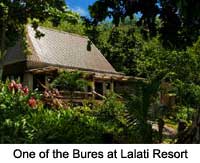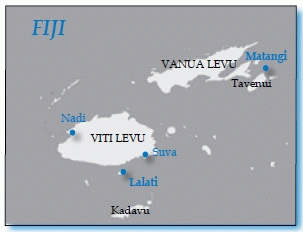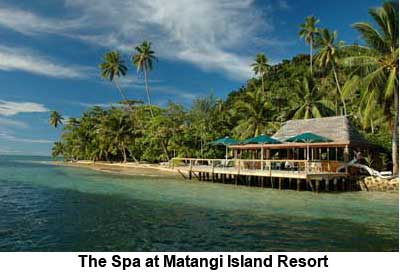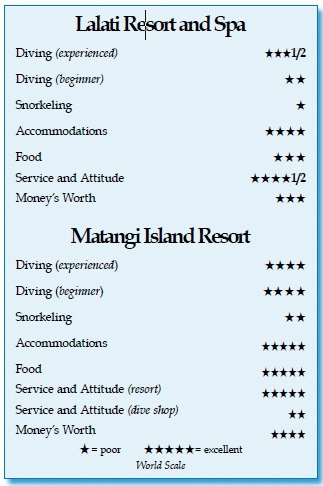Lalati Resort and Matangi Resort, FijiContents of this Issue: Jost Van Dyke, British Virgin Islands Lalati Resort and Matangi Resort, Fiji Fiji Airlines’ Abysmal Service CO Poisoning Risk Higher Than You Think Good Feedback from Our Readers Four Steps to Ensure Your Air is Clean Why Doesn’t DAN Have the Same Insurance Standards Worldwide? Environmental News about Baja California, Australia and DEMA Editorial Office: Ben Davison Publisher and Editor Undercurrent 3020 Bridgeway, Suite 102 Sausalito, CA 94965 dive luxury living: a tale of two islands from the July, 2012 issue of Undercurrent
Dear Fellow Diver: After two decades of liveaboard dive vacations exclusively, my spouse and dive buddy decided she was ready for less diving and more onshore relaxing. (Is that what getting older does to you?) Fiji has a number of picture perfect resorts, so we booked two six-day stays at resorts that appeared to combine luxurious accommodations with excellent diving -- Lalati Island Resort on Beqa Island (pronounced "Benga") and Matangi Resort on Matangi Island, near the much larger island of Taveuni. After a 12-hour red-eye flight from LAX to Nadi, I slumbered through a twoand- a-half-hour van ride and a thirty-minute boat ride to Lalati. Only the beauty of the tropical layout and the staff harmonizing a traditional Fijian welcoming song cleared my foggy brain. On-site managers Chris and Sarah, a friendly English couple, got us quickly settled into our non-traditional bure -- no thatched roof, but a sturdy tin one, on which the rain beat a noisy tattoo. (This is the rainiest region of Fiji; rarely do divers report week-long stretches of dry weather.) Our sizeable bure was about 40 by 18 feet, with the bedroom, bathroom with composting toilets (a fan might have reduced the bathroom dampness) and a side room. High ceilings, hardwood floors, plenty of seating and ceiling fans over the beds (no A/C). While the treated rainwater is considered drinkable, other drinking water is available in the main building, and bottled water is for sale. Towels and sheets were changed mid-way through our six-day stay.
While most of Fiji is seriously fished, reef life is rich and diverse. On my first dive, Paul pointed out blue ribbon eels, a black juvenile eel and even dwarf lionfish. I marveled at a field of garden eels, clownfish wriggling into their anemones and an eightinch scorpion fish. On another dive, I spotted a green turtle, and a few four- to five-foot reef sharks appeared on many dives. Once, a big manta ray swam near the boat. Paul, who had never seen a manta in the shallows near a dive site, thought its fin tips were trevally dorsal fins, so we were all slow to don our mask and fins and jump in. On our one sunny day, we came across a small pod of spinner dolphins that rode our bow wave, leaped and pirouetted. My dive buddy slipped in to get an underwater sighting, which, to the surprise of the crew, she did. I followed her in and spotted several dolphins below, with shafts of sunlight bouncing off their backs.
The dive staff carried our gear and set up our tanks. Their 20-footer has twin outboards and can comfortably handle up to eight divers, while they used the smaller, more economical, single-engine boat if four or fewer divers showed up. Both are fully covered and kept at the pier next to the dive shop. Giant stride entries were easy off the low stern, and a small ladder made exiting the water simple. The larger boat had tank racks; we used the smaller boat once and just laid our tanks on the deck. Two Fijians piloted the boats - capable and experienced Paul, and Louie, obviously in training and with a propensity for eating most of the mangos in a cooler brought onboard for the guests. They use cell phones for communicating with the resort, which worked very well. One day, a large boat from Beqa Lagoon Divers, on the other side of the island, pulled up to the same mooring as ours, despite none of the nearby sites being occupied. That's just rude, by any standard. The boat was packed with around 20 divers but fortunately, we saw few of them underwater.
Although the resort only offers two dives a day and no night dives, one can shore dive endlessly; I gave it a go the first day, about all I could handle with jet lag. The small reef was silty and unspectacular, but there were things to photograph even under the pier, where a dwarf lionfish lolled about. Lalati offers a "shark dive" for $88/person, but I'm no fan of shark circuses so I skipped it. Later, a diver told me the sharks were so well-fed that the bait didn't excite them much. Kirsty said they would draw up to eight species of sharks, including bull, silvertip, even the occasional small mako and tiger, no friends of humans. One wonders if someday a rogue will join the group, with adverse consequences. Regardless, I was quite satisfied with Lalati. Whenever I walked the grounds, cheerful staff members always directed a hearty "Bula" my way -- and the diving and the divemasters were topnotch. As we headed toward Matangi, I wondered how much better lolling about could be, given that the resort was almost twice the price of Lalati. It was an arduous journey to Matangi, but when our boat beached and we waded ashore at a gorgeous, white sand beach in a lush South Seas setting in front of the main building, I knew it would be worth the travel inconveniences. A dozen staff members serenaded us with a sweet welcoming song (a tradition at most Fiji resorts), and they were delighted to see a California family who had arrived with us; it was their 22nd visit to Matangi. Accommodations are super: either traditional thatched bures or "treehouses" perched on stilts next to a massive tree. The floors, counters and cabinets are dark hardwood, woven matting or reeds cover the interior walls, and bottled drinking water is replenished daily, as are towels. A/C is above the bed, which is enclosed in diaphanous netting. Adjacent to the bathrooms are private outdoor showers, a treat in a tropical climate. Daily laundry services are free (which they should be for the price). The enormous central dining area is surrounded by chairs, couches and even a few "hanging" beds by the pool area. Every one of the staff was friendly and welcoming.
The two fully covered, aluminum, single-engine dive boats are about 18 feet long and would be cramped with just eight divers. Both had four-step ladders for exits, but the top step was missing on one, so my short dive buddy found it difficult to ascend; she learned to take off her BC and tank in the water and hand them to the boat driver to lift on board, not her normal practice. Actually, it should be. That extra load risks an accident when climbing into small boats. Giant stride exits were easy off the stern. The boats have radios but there was no oxygen. The staff set up our BCs and regulators, carried the gear on and off the boat, and provided mesh bags for the rest. Oddly, only two- and three-pound weights were available; no singles. Even at such a pricey resort, boat departure was on "island time." I soon learned there was no point in being ready before 9 a.m., even though on the first dive day we were asked to be at the dive center at 8:30. Most of the sites were just a 15-minute ride, though occasionally we spent a half hour in transit. Once, we did the surface interval at the resort because the boat was too full to carry additional tanks for all 10 divers, though we were diving sites just a few minutes away. Other times, the surface interval was on the boat, but twice we went ashore at beautiful little bays. Regardless, all was forgotten when I descended underwater. The visibility, up to 60 feet, was much better than at Lalati because there were no nearby river mouths. The sites seemed prettier than Lalati's typical bommie clusters -- sloping fields of hard corals that appeared to go on forever and were teeming with a huge variety of fish made an hour's dive pass quickly. Besides the usual suspects, Ali and fellow dive guide Elia took care to point out a tiny pipefish that looked like the stem of a leaf, a remarkably cryptic stonefish, a comet (Calloplesiops altivelis, black with rows of white spots) hiding in a coral crevice, and psychedelic nudibranchs and flatworms. Big animals were minimal: an eagle ray and a couple of curious white-tip reef sharks. The soft corals seemed not as common as they were off Lalati, where the currents were stronger. However, on one dive we were dropped in near a point where a fast current ran; I was last off the boat and had to crawl hand-over-hand along the reef -- giving thanks for my gloves all the while -- and around the point to catch up to the group. The soft corals were in full bloom. There were also some stunning wall dives with intricate cuts, where the reef tops come to within 20 feet of the surface, perfect for a long safety stop. Lalati normally offers a trip to the famous Great White Wall, more than an hour away (for a steep $135 per person, although a group could try negotiating that down), but during my stay I was told the currents were too rough and would sweep divers right off the wall. On most mornings, it was clear and relatively calm; only a few days had any significant rainfall. However, it is not unusual to have several cloudy and rainy days in a row during the November-to-February summer season, so be prepared for that possibility. The enormous, high-roofed dining hall next to the pool looked like it could easily seat 50, but the resort was no more than two-thirds full during my stay, and there were never more than 20 people present at a time. They served consistently fresh and delicious meals at the tables, with more than ample portions, including unlimited non-alcoholic drinks, breakfast fruit and afternoon snacks. One evening, we were treated to traditional Fijian dancing and songs by the local village members. Lalati may be a better value for divers, as the diving is more exciting (if you like currents). Matangi is more luxurious and correspondingly more expensive, and while the reefs are beautiful, there seems to be not as much big animal action. Matangi cost far more than any resort I have visited, and I worried that I would come away feeling I had wasted my money. Truth is, it was worth it. But keep in mind that neither location is a dedicated dive resort, nor were many of the guests divers, so the conversation was not "all diving all the time." But then, sometimes that's a good thing when relaxing in paradise. -- B.L.B.
|

I want to get all the stories! Tell me how I can become an Undercurrent Online Member and get online access to all the articles of Undercurrent as well as thousands of first hand reports on dive operations world-wide
| Home | Online Members Area | My Account |
Login
|
Join
|
| Travel Index |
Dive Resort & Liveaboard Reviews
|
Featured Reports
|
Recent
Issues
|
Back Issues
|
|
Dive Gear
Index
|
Health/Safety Index
|
Environment & Misc.
Index
|
Seasonal Planner
|
Blogs
|
Free Articles
|
Book Picks
|
News
|
|
Special Offers
|
RSS
|
FAQ
|
About Us
|
Contact Us
|
Links
|
3020 Bridgeway, Ste 102, Sausalito, Ca 94965
All rights reserved.

 Paul and Kirsty, another friendly English ex-pat couple, serve as the divemasters
and also manage the dive operation, which has two compressors, a selection
of rental gear, rinse tanks and lots of space for storage and hanging up
suits. They offer aluminum 80s, and three smaller tanks for smaller divers.
Bottom times were at our discretion, based
on our computer limits, and the one-hour surface
intervals were spent on the boat. Water
temperatures in December averaged 77 degrees,
with air temperatures in the mid 80s.
Paul and Kirsty, another friendly English ex-pat couple, serve as the divemasters
and also manage the dive operation, which has two compressors, a selection
of rental gear, rinse tanks and lots of space for storage and hanging up
suits. They offer aluminum 80s, and three smaller tanks for smaller divers.
Bottom times were at our discretion, based
on our computer limits, and the one-hour surface
intervals were spent on the boat. Water
temperatures in December averaged 77 degrees,
with air temperatures in the mid 80s. At Lalati, however, there was no
shortage of what Fiji is famous for: lush
soft corals in a rainbow of colors, hard corals, sea fans so wide I couldn't
reach each edge with arms outstretched, stunning sea stars, cleaner shrimp and
bizarre nudibranchs. Because Beqa passage is famous for "ripping" currents, as
Kirsty put it, they always put out a current line. Once, they rejected a site
where a bobbing buoy signaled a tough current. On a typical dive, I would drop
in on a bommie coral head, kick downward and let the current carry me along walls
that bottomed out at 70 feet or more. But rain runoff from nearby Viti Levu (the
Fijian "mainland") often produced visibility of less than 35 feet, so sweeping
vistas were conspicuously absent. After drifting for a bit, the guides would lead
us through a cut between bommies to calmer waters, though we had to stay close
or risk losing sight of them. On one cloudy day, Paul appeared to lose track of
where he was, as the visibility dropped to less than 15 feet.
At Lalati, however, there was no
shortage of what Fiji is famous for: lush
soft corals in a rainbow of colors, hard corals, sea fans so wide I couldn't
reach each edge with arms outstretched, stunning sea stars, cleaner shrimp and
bizarre nudibranchs. Because Beqa passage is famous for "ripping" currents, as
Kirsty put it, they always put out a current line. Once, they rejected a site
where a bobbing buoy signaled a tough current. On a typical dive, I would drop
in on a bommie coral head, kick downward and let the current carry me along walls
that bottomed out at 70 feet or more. But rain runoff from nearby Viti Levu (the
Fijian "mainland") often produced visibility of less than 35 feet, so sweeping
vistas were conspicuously absent. After drifting for a bit, the guides would lead
us through a cut between bommies to calmer waters, though we had to stay close
or risk losing sight of them. On one cloudy day, Paul appeared to lose track of
where he was, as the visibility dropped to less than 15 feet. The resort's dining area, kitchen and office took up the main building, a
comfortable place to hang out. Meals were
served at the table instead of buffet style.
I found the food fresh and tasty in general,
but a couple of the lunches were scanty
(e.g., a very small salad with two pieces
of seared ahi, a boiled egg cut in half
and three pieces of potato). They offered
fruit at breakfast, but only four pieces,
and when I asked for more, I was told there
would be a charge. They suggested I gather
fallen mangos for snacks, so I did. Given
what readers report of fine meals at Fijian
resorts -- and what we found at Matangi --
I think Lalati could step up its menu and
serving sizes.
The resort's dining area, kitchen and office took up the main building, a
comfortable place to hang out. Meals were
served at the table instead of buffet style.
I found the food fresh and tasty in general,
but a couple of the lunches were scanty
(e.g., a very small salad with two pieces
of seared ahi, a boiled egg cut in half
and three pieces of potato). They offered
fruit at breakfast, but only four pieces,
and when I asked for more, I was told there
would be a charge. They suggested I gather
fallen mangos for snacks, so I did. Given
what readers report of fine meals at Fijian
resorts -- and what we found at Matangi --
I think Lalati could step up its menu and
serving sizes. The dive operation, run out of a small building near the dining hall, has
a modest amount of rental gear, an open-air covered area where you can hang BCs
and suits, and two small rinse tanks. They only offer aluminum 80s and, as I
discovered, all with ancient O-rings. On the first tank I set up, I could hear
an air leak at my yoke. I asked Ali, the Fijian divemaster, if she could replace
the O-ring. "Try another tank," she said. It also leaked. A third tank did not. During every dive, I saw bubbles
stream from at least one tank. The
shop had no replacement O-rings. What
other basic items might they be missing? I've never thought to bring
spare tank O-rings with me on liveaboards;
now I see the value in a
"save a dive kit." When I slipped my
dive gloves, on for the first dive,
Ali said, "I don't like divers using
gloves on my reefs." I assured her
my buddy and I would be careful not
to touch the coral and that we preferred
to dive fully covered (we used
full 3mm suits and hoods to stay warm
in the 76- to 78-degree water and
to protect us from stings). After
observing us during the dive, she
said no more about our gloves.
The dive operation, run out of a small building near the dining hall, has
a modest amount of rental gear, an open-air covered area where you can hang BCs
and suits, and two small rinse tanks. They only offer aluminum 80s and, as I
discovered, all with ancient O-rings. On the first tank I set up, I could hear
an air leak at my yoke. I asked Ali, the Fijian divemaster, if she could replace
the O-ring. "Try another tank," she said. It also leaked. A third tank did not. During every dive, I saw bubbles
stream from at least one tank. The
shop had no replacement O-rings. What
other basic items might they be missing? I've never thought to bring
spare tank O-rings with me on liveaboards;
now I see the value in a
"save a dive kit." When I slipped my
dive gloves, on for the first dive,
Ali said, "I don't like divers using
gloves on my reefs." I assured her
my buddy and I would be careful not
to touch the coral and that we preferred
to dive fully covered (we used
full 3mm suits and hoods to stay warm
in the 76- to 78-degree water and
to protect us from stings). After
observing us during the dive, she
said no more about our gloves. Divers Compass: Island Dreams Travel (
Divers Compass: Island Dreams Travel ( 